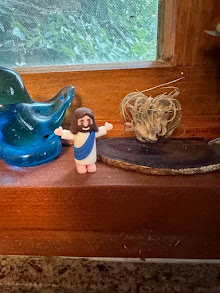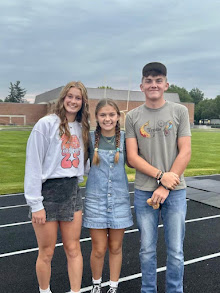
Have you ever visited the National Museum of the American Indian? With overhanging ripples of yellow stone pockmarked with windows like empty black eye sockets, it looks like a little bit of the Southwest deposited on the national Mall. Inspired architecture: just too bad the interior doesn't match up to the promise of the exterior.
But the interior, while light on actual history, is heavy on symbols and Indian interpretations of themselves. The focus is on the modern communities, but I prefer to spend my time with the artifacts of the past: spears and robes, beads, baskets and pottery. I may not understand the language of the totem or the buffalo robe, but I appreciate the artwork.
Many of the tribal displays begin with a creation myth: myth used in the sense of an explanation, a unifying bedrock of origin. I understand these tales. Its not so different in our small towns or multi-generational families. We too have stories we tell over and again about births, weddings, droughts, floods, fires, championships, wrecks and record crops..good or bad. They remind us what and where we come from and if a little embroidery is added, on this level, no harm, no foul.
We moved back to the farm in the back of a '74 Ford truck and Blake's baby blue Ford Torino, one of the worst cars ever to roll off an American assembly line. The Ford truck, on the other hand, became obsolescent long before it actually quit running. We didn't have many belongings, but we did have all my college houseplants and a complete set of John D. McDonald paperbacks. They filled most of the car. We were headed for a little hired man's house on the farm Blake and his brother rented from our New York landlord's family.
And sure enough, as in any good we-had-it-so-bad family saga (how bad was it?), our first winter back on the farm in the little white house was the very worst in many many years. Snow piled up in the roads, the winds were brutal, polar plunges dropped the temperatures well below zero. The roads drifted shut...and stayed that way. Blake's trips back and forth to feed the calves took all day.
The baseboard heaters were no match for the wind coming in the windows, around the windows, under the walls and through multiple other orifices. Heat tape kept us in water most of the time, but an occasional south wind froze us up at the well head, just three feet down at the corner of the house. We had fallen in love with the ornate Round Oak wood stove back in Columbia, but when it came to heating stoves, we were rookies. Picturesque, yes! Practical, no. The firebox would hold a log about 15" long, no more. We sawed, split, and carried twice as many logs as a sensible wood stove would have required.
Like pioneers, we finally barricaded ourselves with blankets in the one room of the house we could keep warm, the kitchen. Like a little old gaffer and granny, I'd sit in my rocker and Blake in his recliner in front of the wood stove, reading, with our feet up and smothered in afghans. At night, we'd warm up the electric blanket and hustle out of our chilly bath to the cozy confines of the bed.
The wind wasn't the only thing that wanted in. A tremendous rattling and scraping in the walls would wake me in the night. Now, I am the kind of person who would lay awake at nights in my grandmother's basement listening fearfully to the tiny mice feet running through the canning jars on the shelves. As a child I would deliberately avoid looking in the bath tub drain in the middle of the night for fear of seeing a giant spider. (I have since toughened up with regard to spiders, adopting a live and let live policy.) This noise was several magnitudes past tiny mice feet. There could only be one verdict: our home was invaded by rats. With no basement and no slab of concrete, the rats had a direct route from soil to ceiling.
We were living in suitably humble circumstances, as befitting newlyweds and entry level employees on the farm. We didn't spend much time thinking about living on two mud roads or driving an extra three miles to get to pavement when it rained. Our well was right out our back door but that meant the washing machine would freeze up the first cold snap. We did have a private phone line and were situated to pick up two of the three network television stations coming out of Omaha. Blake would have to climb on the roof after a particularly windy day and move the antenna so we could watch a favorite show on another network. We watched alot of public tv; the interior UHF rabbit ears brought in a better picture. Sunday television included Washington Week in Review, Market to Market, Louis Rukyser, and, of course, Firing Line.
Before Lee was born, I rode along when Blake did chores, or hauled grain or cattle. We hauled most of the beans over to Brownville and wait our turn in line on the steep steep slope in our trucks with hand emergency brakes. Snap! would go the clutch as we lurched forward in turn.
We'd go to cattle sales or machinery auctions lots of times when the weather was bad. Back then he didn't run the combine much, so it was a big deal when he traded with Grandpa to combine beans on the farm we rented. We just ran beans with the second combine. Suffice it to say, combines have come a long ways since then. No buddy seat, no air conditioning, no rotor, no header control. It was slow, nasty work fraught with hazards. Remember, this was pre-Roundup ready too!! I can well remember standing by pulling massive handfuls of foxtail and sunflowers out of the plugged head.
We didn't travel like we do now. We watched high school sports. We bowled in a league at the Blue Jay Bowl with Millie and Charlie one night a week and we played in the Tarkio College orchestra under the direction of Dr. Crapson. When we started playing, Mary Craig Stevenson was still playing the lone violin. As a matter of fact, it was after a Monday night rehearsal that we got up in the wee hours of the morning to go to Fairfax Hospital to await the arrival of our first child.
Tarkio still had two of just about every kind of retail establishment, but only the HyVee could be considered part of a chain. The Pizza Hut appeared in Tarkio and just a year or two later, Shenandoah got a McDonald's.
We ate out every once in a while. While I was pregnant, we'd go to Curly's for a fried shrimp basket. I know, I know, that reinforces every old wives' tale about the cravings of expectanct mothers, but cliches become cliches for a reason. Blake's grandparents enjoyed taking us all out for supper as well. Sometimes we'd go over to Wheeler's in Auburn, but other times, we'd go to oddball establishments where Grandpa had heard they served good fish. The Rulo River Club was reliable, but I had my doubts the time we ate in Brownville in a single wide trailer with so little heat we could see our breath and smell the kerosene in the air.
We stayed in the little house until summer 1980, moving just two weeks before our second baby was born. Buying a house was a hard decision, but land prices were still very high and we could never dream of the farm crisis and credit crunch that was to come. The summer of 1980 was a brutal one but.....
well, that's another story.





















